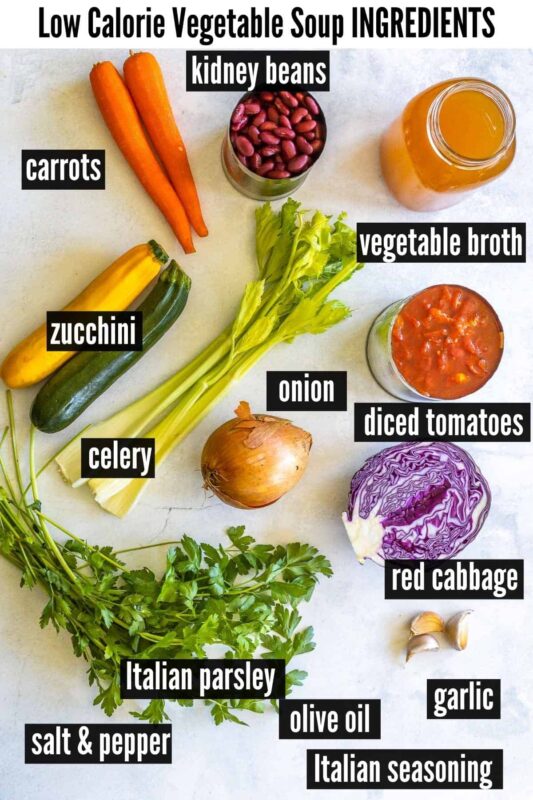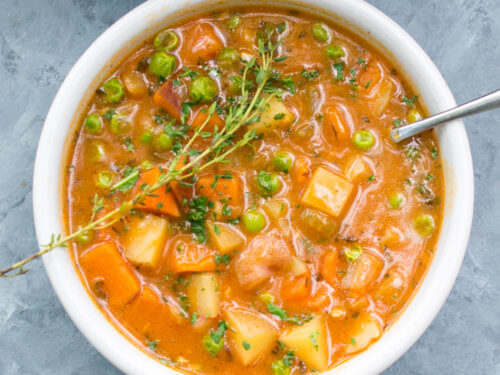Vegetable soup is a nutritious, low-calorie meal that fits into almost any diet. It provides essential vitamins, minerals, and fiber while keeping calorie intake in check.
Many people enjoy vegetable soup for weight management, digestion, and overall health benefits. However, the calorie content can vary depending on ingredients and preparation methods.
Some versions remain light, while others become high in calories due to added oils, creams, or starches. Understanding the calories in vegetable soup helps make informed dietary choices.
A simple broth-based soup with fresh vegetables contains fewer calories, while recipes with potatoes, beans, or pasta increase the total count.
Choosing the right ingredients allows for a flavorful, satisfying soup without excess calories. This content explores the calories in vegetable soup, ingredient variations, and ways to keep it nutritious while maintaining a low-calorie count.
How Do Calories in Vegetable Soup Add Up?

Calories measure the energy food provides. Every ingredient in vegetable soup contributes to its total calorie count. A basic broth-based vegetable soup remains low in calories, making it a great option for weight-conscious individuals. However, adding starchy vegetables, legumes, or fats increases the calorie content.
Cooking methods also impact the calories in vegetable soup. Boiling or simmering vegetables in water or broth keeps the calorie count low. Sautéing onions, garlic, or other ingredients in oil or butter raises the total calories. Thickening agents like cream or flour-based roux further increase calorie density.
Portion sizes play a crucial role in calorie intake. A small bowl of vegetable soup may contain around 80–120 calories, while a larger serving with added ingredients can exceed 250 calories. Tracking portion sizes helps maintain a balanced diet without overconsumption.
Read More
How To Cook Panera Vegetable Soup
How To Cook Tomato Rice Vegetable Soup
Common Ingredients in Vegetable Soup And Their Caloric Values

Each ingredient affects the overall calorie count in vegetable soup. Vegetables generally have low calories but add fiber, and essential nutrients. Below is a calorie breakdown of common ingredients.
Low-Calorie Vegetables:
- Carrots (1 medium): 25 calories
- Onions (½ cup): 30 calories
- Celery (1 cup): 14 calories
- Tomatoes (1 medium): 22 calories
- Spinach (1 cup): 7 calories
- Zucchini (1 cup): 20 calories
Broth Options:
- Vegetable broth (1 cup): 12 calories
- Chicken broth (1 cup): 38 calories
- Beef broth (1 cup): 31 calories
Higher-Calorie Ingredients:
- Potatoes (1 medium): 110 calories
- Corn (½ cup): 60 calories
- Beans (½ cup): 110 calories
- Rice (½ cup, cooked): 100 calories
- Pasta (½ cup, cooked): 105 calories
- Olive oil (1 tbsp): 120 calories
- Heavy cream (1 tbsp): 52 calories
To keep the calorie count low, avoid excessive starches, fats, and creamy additives. Instead, focus on nutrient-dense vegetables, lean proteins, and low-sodium broths. By selecting the right ingredients, it is easy to enjoy a hearty, satisfying vegetable soup without unnecessary calories.
Low-Calorie vs. High-Calorie Vegetable Soups
The calorie content in vegetable soup varies based on ingredients and preparation methods. A simple broth-based soup with fresh vegetables remains low in calories. However, adding high-calorie ingredients like cream, butter, cheese, or excessive starches can significantly increase the total calorie count.
Low-Calorie Vegetable Soups
1. Uses water or low-sodium broth as a base.
2. Includes non-starchy vegetables like spinach, zucchini, and tomatoes.
3. Avoids excessive oils, dairy, and processed ingredients.
4. Contains fewer than 100 calories per serving.
High-Calorie Vegetable Soups
1. Often made with cream, cheese, or butter for richness.
2. Includes starchy ingredients like potatoes, pasta, or rice.
3. May contain high-fat meats, adding extra calories.
4. Can exceed 250 calories per serving.
Homemade vegetable soup allows better calorie control. Store-bought options may contain hidden fats, preservatives, and sodium, making them less healthy. Checking labels ensures better choices when buying pre-made soups.
Ways to Reduce Calories in Vegetable Soup
Lowering the calorie count in vegetable soup involves smart ingredient selection and cooking techniques. Keeping it light while maintaining flavor ensures a satisfying meal without excessive calories.
1. Choose a Low-Calorie Base
Using water or low-sodium vegetable broth instead of cream-based broths keeps calories in check. Bone broth adds protein without extra fats.
2. Limit High-Calorie Additives
Avoid cream, butter, or excessive oil. Instead, enhance flavor with fresh herbs, spices, and citrus. Sautéing in a small amount of broth instead of oil reduces calories.
3. Control Starchy Ingredients
Potatoes, pasta, and rice can increase the calorie content in vegetable soup. Using cauliflower, zucchini noodles, or quinoa instead of traditional starches provides a lighter alternative.
4. Increase Fiber and Protein
Adding fiber-rich vegetables like cabbage, broccoli, and leafy greens makes soup more filling. Lean proteins like beans, tofu, or shredded chicken boost satiety without excessive calories.
5. Watch Portion Sizes
Even a healthy soup can contribute to excess calorie intake if portions are too large. Sticking to a reasonable serving size ensures balanced nutrition.
By following these strategies, vegetable soup remains a low-calorie, nutrient-dense meal that supports a healthy diet.
Nutritional Benefits of Vegetable Soup Beyond Calories

Vegetable soup offers more than just a low-calorie meal. It provides essential nutrients that support overall health, making it a great addition to any diet. While monitoring the calorie content in vegetable soup is important, its true value lies in the vitamins, minerals, and fiber it delivers.
1. Rich in Vitamins and Minerals
Vegetables in soup supply vital nutrients like vitamin A, vitamin C, potassium, and iron. Carrots and sweet potatoes provide beta-carotene, which promotes eye health. Leafy greens like spinach and kale offer iron and folate, essential for red blood cell production. Tomatoes and bell peppers are packed with vitamin C, boosting immunity and improving skin health.
2. High in Fiber for Digestion
The fiber in vegetable soup aids digestion, prevents constipation, and promotes gut health. Fiber-rich ingredients like broccoli, celery, and beans support a healthy digestive system. A fiber-rich diet also helps regulate blood sugar levels, reducing the risk of diabetes.
3. Hydration and Detoxification
Because vegetable soup has a high water content, it helps maintain hydration. Proper hydration supports digestion, kidney function, and skin health. Many soups contain detoxifying ingredients like garlic, ginger, and leafy greens, which help remove toxins from the body.
4. Weight Management and Satiety
A low-calorie soup before meals can reduce overall calorie intake by increasing fullness. The combination of fiber and water in vegetable soup helps curb hunger without adding excessive calories. Studies suggest that consuming soup as a starter leads to lower overall meal consumption.
5. Supports Immune Health
Nutrient-dense soups strengthen the immune system, especially during colder months. Ingredients like garlic, onions, and turmeric have anti-inflammatory properties. Broths made with fresh vegetables provide antioxidants, which fight free radicals and reduce the risk of chronic diseases.
Popular Vegetable Soup Recipes with Calorie Counts
Making homemade vegetable soup allows complete control over ingredients and calorie content. Below are three delicious recipes with calorie counts per serving.
1. Classic Vegetable Soup (90 Calories per Cup)
A simple, nutritious soup with fresh vegetables, herbs, and broth.
Ingredients:
- 1 cup chopped carrots (50 calories)
- 1 cup chopped celery (14 calories)
- 1 cup diced tomatoes (22 calories)
- 1 cup chopped zucchini (20 calories)
- 4 cups vegetable broth (48 calories)
- Garlic, onion, and spices (10 calories)
Preparation:
- Sauté onions and garlic in a small amount of broth.
- Add all vegetables and remaining broth.
- Simmer for 30 minutes until vegetables soften.
2. Low-Calorie Detox Soup (70 Calories per Cup)
A light, cleansing soup loaded with greens and antioxidants.
Ingredients:
- 2 cups chopped kale (70 calories)
- 1 cup diced tomatoes (22 calories)
- 1 cup shredded cabbage (18 calories)
- 4 cups water or broth (48 calories)
- Ginger, turmeric, and lemon juice (5 calories)
Preparation:
- Bring broth to a boil and add vegetables.
- Simmer for 25 minutes.
- Season with ginger, turmeric, and lemon.
3. High-Protein Vegetable Soup with Beans (120 Calories per Cup)
A hearty soup with beans for added protein and fiber.
Ingredients:
- 1 cup black beans (220 calories)
- 1 cup chopped carrots (50 calories)
- 1 cup chopped onions (30 calories)
- 4 cups vegetable broth (48 calories)
- Garlic, cumin, and chili powder (10 calories)
Preparation:
- Sauté onions and garlic in broth.
- Add beans, vegetables, and spices.
- Simmer for 30 minutes.
These recipes provide nutritious options while keeping the calorie content in vegetable soup under control. Making soup at home ensures a healthy, balanced meal.
Conclusion
Vegetable soup is a nutritious, low-calorie meal that supports weight management, digestion, and overall health. Its calorie content varies based on ingredients and preparation methods. A simple broth-based soup with non-starchy vegetables remains light, while adding cream, butter, or excessive starches increases calories.
Understanding the calories in vegetable soup helps make healthier choices without sacrificing flavor. Homemade soup allows complete control over ingredients, ensuring a nutrient-dense meal without unnecessary fats or preservatives.
Choosing fiber-rich vegetables, lean proteins, and low-calorie broths enhances both taste and nutritional value. Portion control also plays a key role in maintaining a balanced diet. Whether for weight loss, detoxification, or general well-being, vegetable soup remains an excellent dietary choice.
With the right ingredients and cooking techniques, it provides a satisfying, wholesome meal that supports long-term health goals. Making mindful choices ensures that this classic dish stays both delicious and nutritious.
